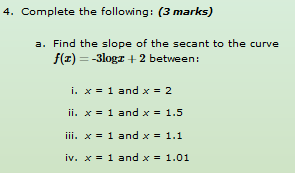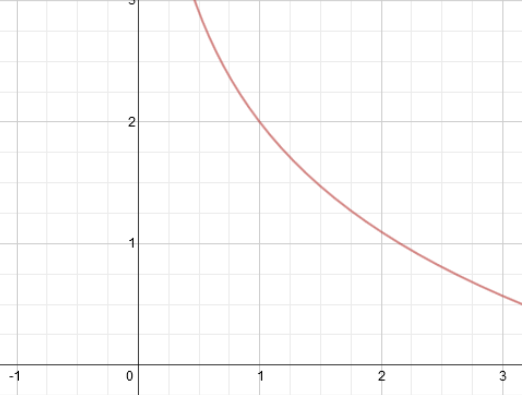Vela1
- 2
- 0
The question was too long to post in the title so I just wrote down the first part. I hope this is alright. Here is the question that I am doing right now:

This is the graphical representation (thanks to Desmos Graphing Calculator):

So I have substituted the points in the equation to get their respective y-values.
For example:
f(1.1) = -3log(1.1)+2
f(1.1) =~ 1.87
I've done the questions myself using this method to find the slope of the secant line, and I wanted confirmation that I was doing it right.
----------------------------------
I've written it on paper and unfortunately I don't have a scanner so I will just type out (i) and (ii) to show my rationale.
4.a)
i] m = (Y2-Y1) / (X2-X1)
= (1.097-2) / (2-1)
= -0.903 / 1
m = -0.903
ii] m = (Y2-Y1) / (X2-X1)
= (1.472-2) / (1.5-1)
= -0.528 / 0.5
m = -1.056
------------------------------------------------
I just wanted to know if I was doing it correctly, and if not how can I answer this question? Thanks in advance.

This is the graphical representation (thanks to Desmos Graphing Calculator):

So I have substituted the points in the equation to get their respective y-values.
For example:
f(1.1) = -3log(1.1)+2
f(1.1) =~ 1.87
I've done the questions myself using this method to find the slope of the secant line, and I wanted confirmation that I was doing it right.
----------------------------------
I've written it on paper and unfortunately I don't have a scanner so I will just type out (i) and (ii) to show my rationale.
4.a)
i] m = (Y2-Y1) / (X2-X1)
= (1.097-2) / (2-1)
= -0.903 / 1
m = -0.903
ii] m = (Y2-Y1) / (X2-X1)
= (1.472-2) / (1.5-1)
= -0.528 / 0.5
m = -1.056
------------------------------------------------
I just wanted to know if I was doing it correctly, and if not how can I answer this question? Thanks in advance.
